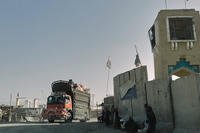As the U.S. military prepares for future fights that may see units dispersed and on their own for extended periods of time, it needs new, lighter rations that will keep troops fueled for the mission.
The Army's Combat Feeding Directorate in Natick, Massachusetts is working on solving that problem now. Scientists are prototyping a "close combat assault ration'' containing an assortment of nutrient-dense energy bars that may augment the standard-issue meals, ready to eat -- MREs -- or even replace them.
Read Next: Navy Orders Aviation Stand-Down After Plane Crash Kills 2 in Alabama
"This is a ration that's designed to be extremely lightweight and compact," Lauren Oleksyk, team leader for Food Engineering, told Military.com in an interview earlier this month. "Some of the first prototypes will be field-tested in the near future. The bars that we're looking at for that ration are not necessarily full meal-replacement bars, but [we're] using a technology for drying and compression that would enable us to make a full meal-replacement bar if needed."
That moisture-reduction technology is good for a serious decrease in weight. In the lab, she said, Natick scientists have been able to reduce the weight of individual components by anywhere from 40-70%. The goal, she said, is to achieve an overall weight reduction of 40%, allowing troops to carry more food without increasing their combat load. A similar reduction in volume by compressing the packaging is also possible, she said.
"You can dial in how much [moisture] you want to remove for palatability purposes," Oleksyk said. "We know that warfighters don't necessarily want to consume all dry bars, so we want to be able to offer a variety of moistures in these products so that it's something they want to consume."
Early reviews of the prototype are favorable. Army Lt. Gen. Ted Martin, deputy commanding general of the Army's Training and Doctrine Command, got an early taste of the offerings this month. He shared with Military.com photos of a packaged caramel cheesecake slice -- 280 calories -- and unwrapped samples of other items, including a cherry dessert bar, vanilla lemon cheesecake, salted caramel bar and tart cherry bar.
"I had my doubts but was actually very impressed with the food," Martin told Military.com via Twitter message.
Calling himself a "pretty picky eater," Martin said he nonetheless liked the things he sampled and the compactness and relatively light weight of the ration.
"Unlike an MRE, I got the feeling that I would eat everything in the ration and not end up throwing away half of it," he said.
MREs weigh on average 18 to 26 ounces and include weight-adding accoutrements such as a flameless chemical heater and condiments. They include an entree and a number of sides and contain an average of 1,250 calories.
While the close-combat assault ration may not immediately replace the MRE, there's a definite trend in military food science to develop dryer, lighter, more condensed meal solutions that still manage to leave troops feeling satisfied.
"Soldiers in small units might be in environments where they have to go longer without resupply," Oleksyk said. "So right now, we're very focused on reducing the logistics burden by reducing the weight and size of ration so that soldiers in small units can carry more. And this is becoming critically important, and it's dictating the development of smaller and more compact, nutrient-dense foods."
Hear the rest of the interview with Lauren Oleksyk on the Left of Boom podcast beginning Oct. 29.
-- Hope Hodge Seck can be reached at hope.seck@military.com. Follow her on Twitter at @HopeSeck.












